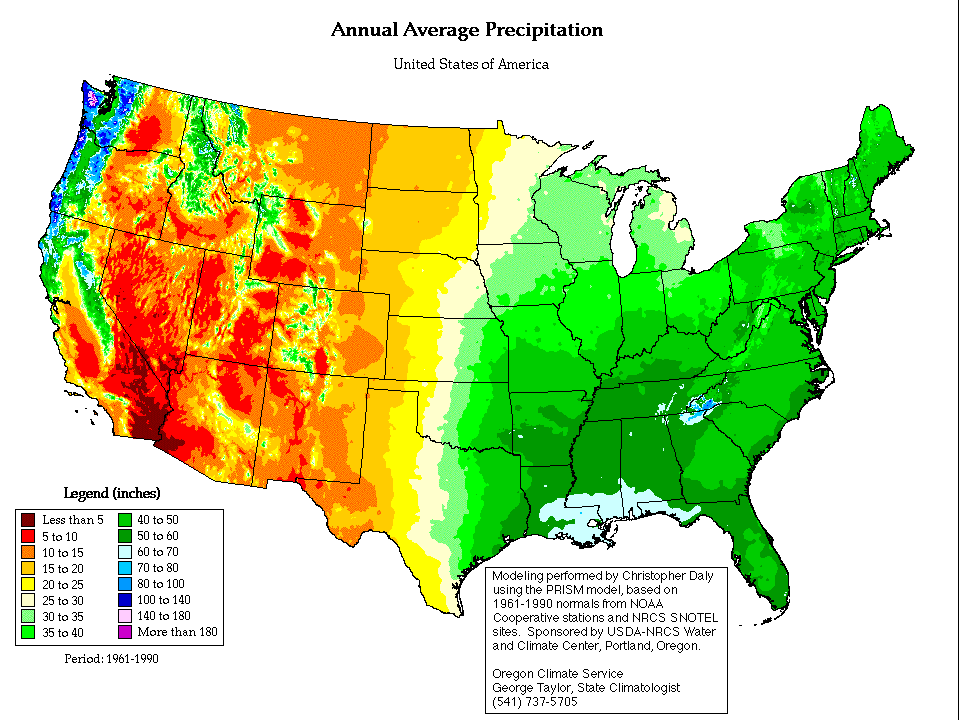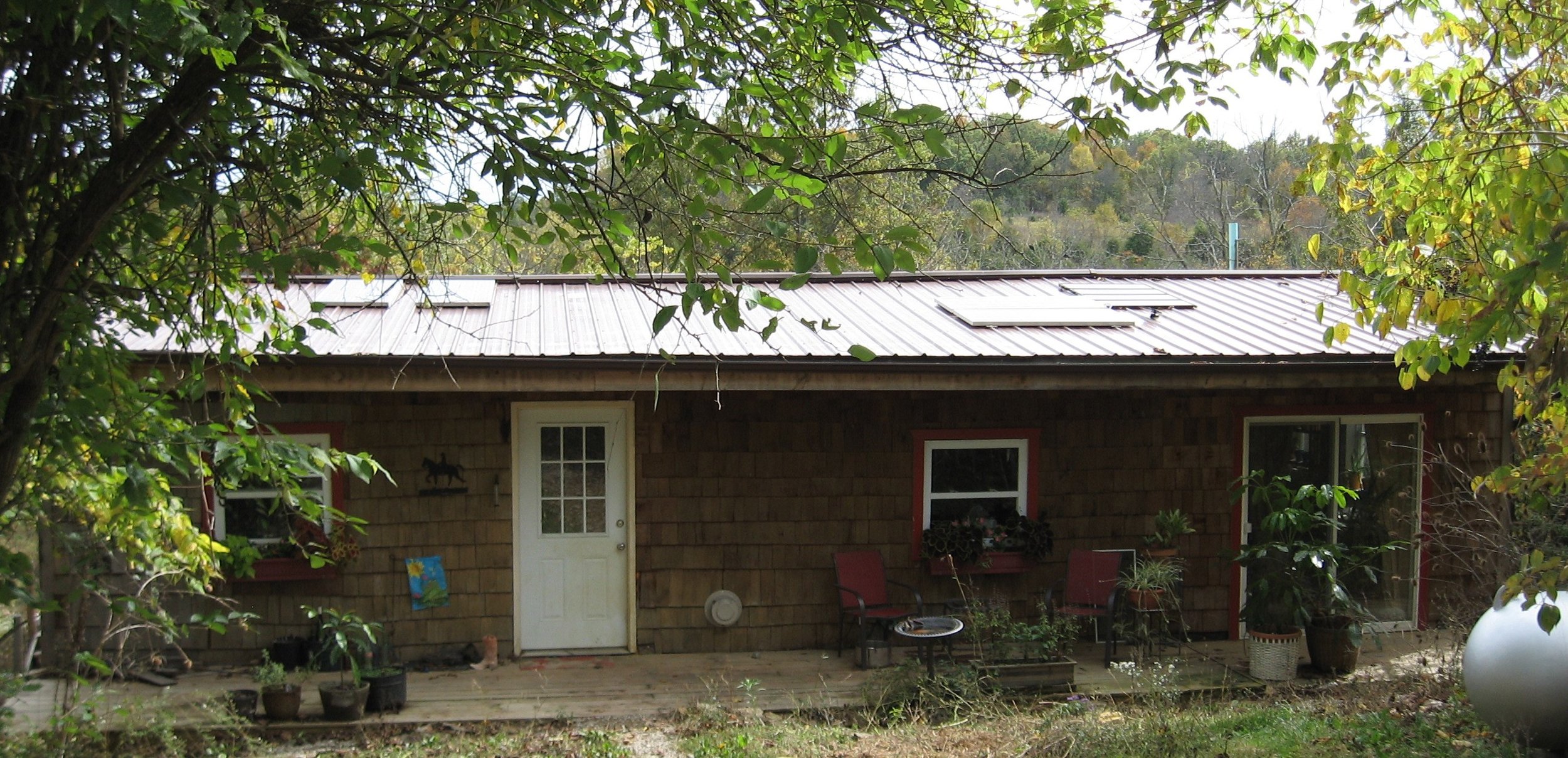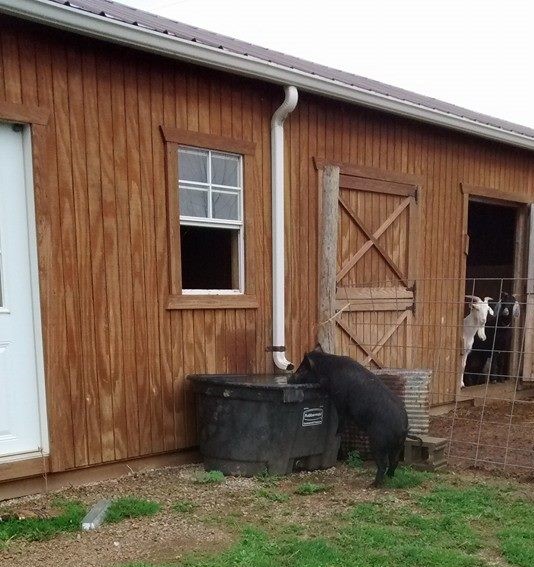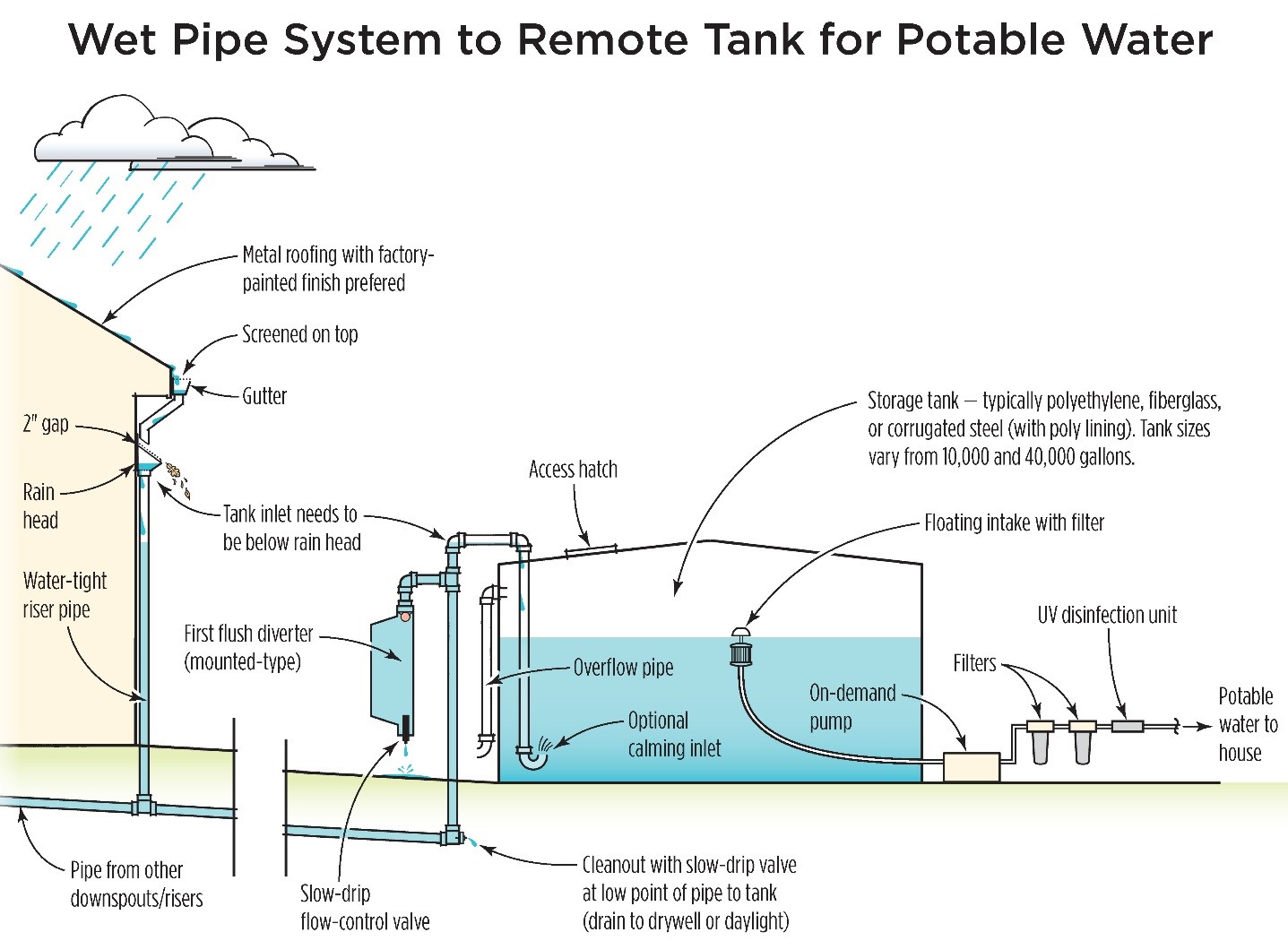Updated April 11, 2023
Every year thousands of gallons of water falls to the ground in the form of precipitation. Rainwater harvesting is simply collecting that rain (or snow) in storage containers for future use. Many people around the world harvest rainwater to help meet their water needs.
Water is not something we can do without. After all, 60% of the human body is water. Even if you live in a modern city, it is well worth your time to develop some rain catchment strategies. Even a 50-gallon drum can help water your garden or be used during an emergency.
There are still people in the USA without access to “city” water. Fortunately, I am one of those people. I have not been forced to pay money to hook up to a system that then charges me monthly for a commodity that falls from the sky.
Collecting rainwater needs three things. An appropriate roof, a drainage system, and a storage tank. You can collect water in a rain barrel, a stock tank, or a larger cistern.
Is Collecting Rainwater Legal?
It makes me sad that I even have to write this section. Collecting the rain that falls on our property should be a given right for all of us. After all, when we collect and conserve our water we are being good global citizens.
But not all states see it that way. Individual states regulate their rainwater collection policies.
In my home state of Kentucky, we encourage the conservation of water. Collecting and storing rainwater is a legal and accepted practice. Wisconsin also allows water collection.
Some places, such as Austin Texas, offer homeowners a rebate of up to $5000 for installing a rainwater collection system.
But there are states that have restrictions on rain harvesting. These states see rainwater as a public commodity that is owned by the state. States such as Colorado, Arizona, Oklahoma, and Utah have regulations and restrictions that residents should be aware of before installing a rain catchment system.
Other states such as New Mexico only regulate the water if it is used inside the home.
You can find an interactive map on the Department of Energy’s website that gives a breakdown of water collection laws for each state.
Know the policies in your state before you build your system.
Best Books To Learn About Collecting Rainwater
A great new book on the subject is Harvesting Rainwater for Your Homestead by Renee Dang. This book has easy-to-follow directions and lots of pictures.
Another great book that is a bit more up to date as far as technology is the Essential Rainwater Harvesting by Rob and Michelle Avis.Just follow the link below to learn more about getting started harvesting rainwater. I like this book because it focuses on DIY off grid systems and has a lot of information on filters and disinfection options.
Is Rainwater Better Than Tap Water?
Rain is a great source of water for many reasons.
It does not come with a monthly bill. After you install your system your water is free.
The water is “soft” because it does not yet contain salts or minerals. Water picks up minerals when it travels through the ground. Soft water is preferred for cleaning because there is no mineral residue.
Rainwater is sometimes considered to have an off flavor. This is because it naturally is free of sodium and minerals. Communities treat our tap water with minerals to enhance the flavor. Rainwater will need to be filtered if it is being used for drinking.
Is Rainwater Safe To Drink?
As children, we all liked to lift our faces and arms up to the sky during a summer shower. The water was so cool and delicious after a hot day of outdoor play.
Those memories aside, rainwater is not safe to drink on a regular basis.
Water droplets in the clouds can pick up pollutants long before they fall to Earth. Air pollution, dust, and smog can rise up and enter the clouds where they are absorbed into the water molecules.
When the water hits your roof and runs down it picks up contaminants on the way. Dirt and bacteria may be on your roof. A bird may have gone to the bathroom on your roof and the waste gets washed into your storage tank.
Rainwater is great for watering livestock and gardens. It is good to bathe in and will leave your hair soft and shiny.
However, if you are going to drink from your rainwater supply you will need a filtration system designed to remove harmful pathogens and bacteria. I have a Big Berkey Water Filter. There are many different models and you can find one that meets your needs.
The Berkey filters are non-electric so they are great for off-grid living or in an emergency. Look for a good filtration system that gets rid of the bad stuff like chemicals, bacteria, viruses, and parasites. In addition, you want your water filter to remove sediment, bad-tasting minerals, and odor.
Is Collecting and Harvesting Rainwater Environmentally Responsible?
YES! Being an active participant in the water cycle helps you to be conscious of your water usage. This means that you will conserve and protect your water which helps everyone.
Many modern homes take the rainwater and run it into the community sewer system. Not only does this remove a valuable resource from you it also often leads to widespread pollution. The water picks up contaminants that are sent to the local sewer plant. The sewer plant uses energy and chemicals to clean the water.
Rainwater is better for your garden because it does not contain chemicals, specifically chlorine. Excess chlorine can burn plants and cause their leaves to turn yellow and die. In addition, it harms the beneficial microbes in the soil.
Using drinking water to flush our toilets is just irresponsible. Many toilets use five gallons of clean water to push our pee and poop into a sewer system. That is wasteful and not a good use of our resources. Read my blog Composting Toilets Are Great: No Sh*t!
When we collect rainwater we are conserving an important resource.
The Roof – The First Step To Collecting Rainwater
Metal roofs are the best for collecting rainwater for several reasons. The biggest reason is that they are “clean”. A metal roof does not have any particles that will go into the water supply.
A metal roof is also a smooth surface that allows the water to flow without diversion. Galvalume®, is a specially designed metal roofing material. It is a fifty-five percent aluminum and forty-five percent zinc alloy-coated sheet steel.
An asphalt roof, made with the popular tar shingles, loses tiny pieces of tar and chemicals that enter your water supply. If this is the type of roof you have you will need to add an extra step. Install a filter to catch the particles before they enter your tank.
If you plan on using the water for drinking you will need to take further precautions. Water testing will be necessary to make sure chemicals from the shingles are not leaching into your water. You will also need a more advanced filtration system.
Metal roofs also lose less water to evaporation. A tar or asphalt roof will lose up to 15% of water to evaporation. (The Home Water Supply pp. 25, see link above)
My metal roof supports my solar panels as well as a gutter system which leads to a cistern under the back porch. Fox Run Environmental Education Center
How Much Rainwater Will You Be Able To Collect?
The short answer is A LOT! Or at least more than you think.
That question contains many parts. The first part that you want to examine is – how much precipitation does my geographic area receive. This can be in the form of rain or snow.
The US Climate Data Website gives precipitation figures for states and cities.
The collection surface is the footprint or square footage of the roof. The pitch does not matter as long as the water is flowing into a container.
The standard formula to figure out how much you collect:
Square footage of roof X inches of rain x 0.623
So if my roof is 20 x 30 or 600 square feet and I had an inch of rain, I would multiple
600 x 1 x 0.623 = 373.8 gallons. and if I figure I lose 15 % that would give me 317.73 gallons going into my tank. You can see how even a small roof catches quite a bit of rain.
Water Cache has a great online calculator to help you determine how many gallons you will collect.
https://www.watercache.com/resources/rainwater-collection-calculator
Keep in mind that these figures are ideals. Some water may be lost to the first flush divergent, possible leaks in the system, or to overflowing gutters.
Also, keep in mind that rainfall is an event. Rain does not fall in even numbers throughout the year. It may come as a major thunderstorm or it may be a short summer shower.
The Drainage System
The most popular drains are gutters that are attached to your home. Many gutters are designed to take the water underground or simply discharge it onto the lawn. (Such a waste). You can run your gutters to wherever you want them.
A gutter is simply a metal or plastic tube that is designed to carry the water from the roof to the tank. The gutter attaches to the house just under the roofline. The downspout runs from the gutter to the tank.
In addition to the gutters and downspouts, you will want to have a wire mesh leaf guard. This will fit over your gutter to prevent leaves, twigs, or other debris to enter and clog up the gutter. You can also purchase strainer baskets to attached to the bottom outlet of the downspout.
Houses with a single floor and uniform roof are often easy DIY projects to install gutters. Gutter installation becomes more complicated if you have a multi-level roof or a T design. In that case, it may be best to consult with a gutter contractor.
I put gutters on every building I build. House, barns, sheds…. Anything that has a roof is fair game for gutters. I have even put a gutter on a chicken tractor.
I also use a variety of tanks for catching the water. The picture below is a livestock tank that catches water for barn use. I have a large cistern style tank under my back deck for household use.
Gutter and stock tank on the rear of my goat barn. Miss Piggly Wiggly likes the self serve option. Fox Run Environmental Education Center
Storage Tanks
Storage tanks can vary from a 50-gallon rain barrel to a 3000-gallon cistern. And if you are like me – a Do It Yourselfer – you will have a variety of systems.
You may see the terms dry and wet system. Of course, all rain is wet – right? 😉
A dry system is a smaller system that depends on gravity. So a rain barrel. It is subject to dry out in between rains and thus not be used.
A wet system is a larger system that uses pumps and pipes to move the water where you wish it to go. An underground cistern that provides water for a house would be an example.
I built my water catchment system over many years. As I said I have gutters on everything from my house to the mobile field houses for the livestock. My storage tanks vary as well from a 50-gallon rain barrel to the 750-gallon cistern under the house.
The size of your tank will depend on the size of the roof and how much water you will collect as well as what your purpose with the water will be.
For instance, I don’t like hauling water buckets around the field to where the livestock and wildlife live. I have movable field houses for them to get out of the weather. These sheds are small but can easily fill a 100-gallon tank. That way when it rains their tank fills. I use this tank to then put water in their buckets.
I added a small water tank to this mobile livestock shed to provide water to animals in the back field. Fox Run Environmental Education Center.
The barn near the gardens has a stock tank and an above-ground cistern that I use to water the gardens and the orchard. The cistern is uphill from the gardens. I purchased an adapter unit so I could attach a garden hose. I can then simply water the garden on gravity feed.
Rain Water Room
Many homes back in the day were built with rainwater rooms. This room was often situated at the top of the home in the attic and over the bathroom. The room featured a tank to hold water. When it rained water was diverted into the tank. There were two spigots. An overflow spigot and one that let the water run into the bathroom tub and sink.
The major disadvantage of this is the weight of the water. You must have a very secure and reinforced floor under the tank.
Rain Barrels
Rain barrels are an easy way to start your quest for water conservation. They are smaller, typically 50 – 75 gallons, and fit in an out-of-the-way corner. Rain barrels are also nice if you live in the suburbs where your neighbors may question a larger tank.
Rain barrels have a limited capacity and often overflow. However, there is no limit on how many rain barrels you can put around your house. I have a friend who has one at each corner of their city residence for a total capacity of 300 gallons.
You can either adapt a rain barrel using a spigot kit or you can purchase a rain barrel online.
Stock Tanks
Stock tanks are those black open containers you see at farm stores. They are typically used by farmers to water livestock. They are wonderful for collecting water that you want to have easy access to.
Watering animals and gardens are common uses. On a side note, they also make a great “bathtub “or place to cool off.
They are uncovered so they are accessible to dirt and leaves falling in them.
You will want to use caution if you have toddlers since they are open to the water. I have placed a piece of fencing over one of mine to keep my springer spaniel from jumping into it.
SMALL ABOVE-GROUND CISTERNS
Some of these just look like very large rain barrels. Some are more oval in shape. They are made of plastic and will have a rating.
In some states, you may be required to cover openings with fine mesh to prevent mosquitos from breeding. Tanks should be as close to the source and the destination as possible. Larger tanks need to be on a firm pad such as concrete or stone.
UNDERGROUND CISTERNS
Underground cisterns must be strong to withstand the pressure of the water and the pressure of the soil. In the past cisterns were made of cement and put into place with the foundation of the house.
Water weighs eight pounds per gallon. Situating the tank is important.
Lately, we see more plastic underground cisterns.
Ame Vanorio is the director of Fox Run Environmental Education Center where she teaches classes on alternative energy, organic gardening, and wildlife conservation. Ame has 25+ years of off-grid living experience. Ame’s books are available on Amazon.







